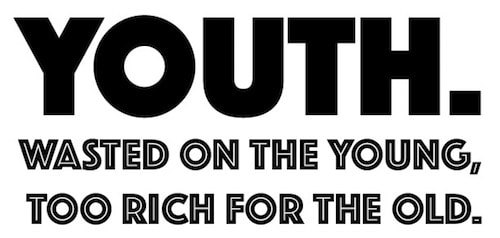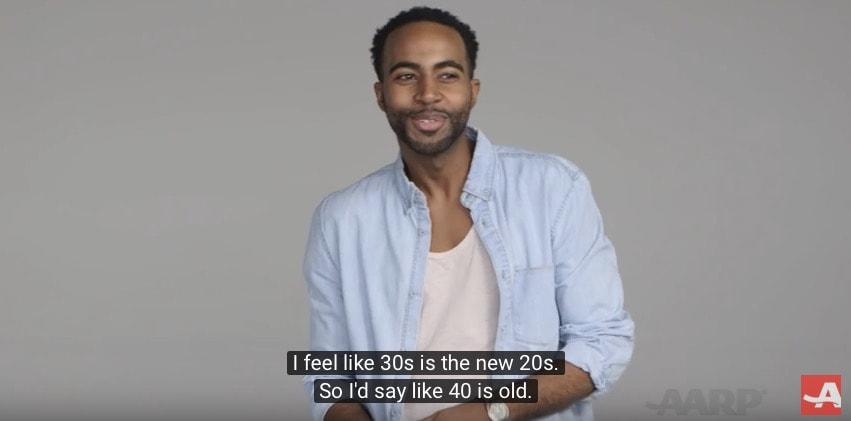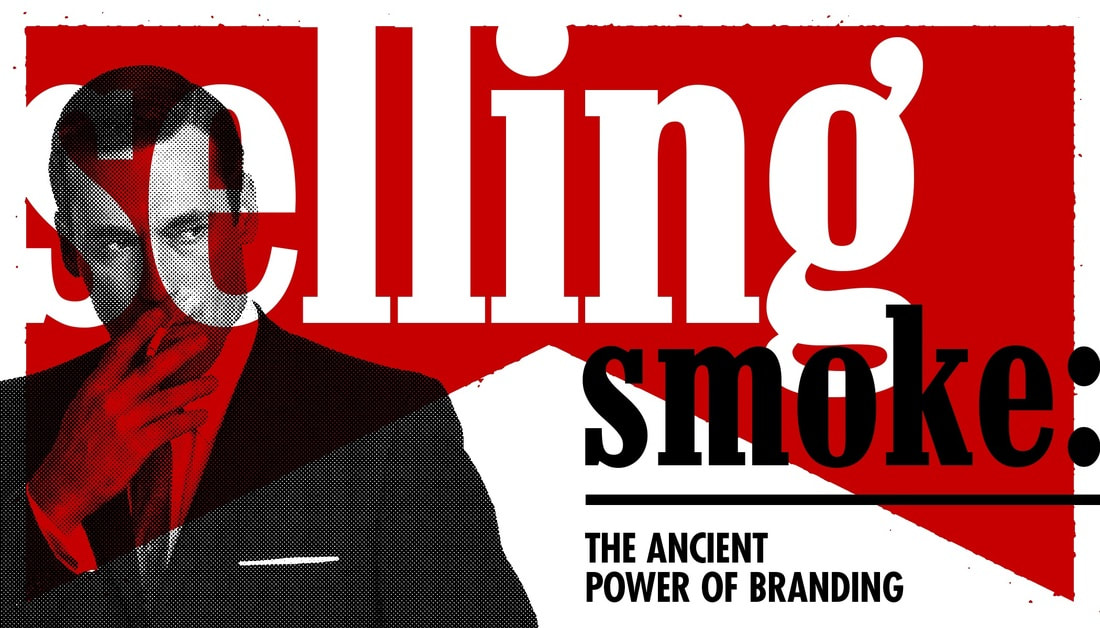|
As boomers enter their twilight years and ask their bodies to defy gravity, I can’t help but wince at some of the stuff coming out of AARP. I’m a boomer myself and get direct mail invites from AARP weekly. Or so it seems. On occasion I see something from AARP on the web and this video caught my attention: Basically, it’s another take on that Like a Girl video in which people’s prejudices are exposed for what they are — that being stupid or insensitive or cruel and the like. But what struck me about this video from AARP was its underlying message — supposedly that what a Millennial thinks is old, isn’t old after all — actually presents a truly unkind image of what it is to be old.
Yes, we keep on hearing how the 60 is the new 40 and 80 is the new 60 and and other nonsense. Jane Fonda still looks great with the right lighting, make-up, and professional stylist on hand. And who knows how many surgical interventions. And yes there’s some 90-year-old guy out there who can do 100 push-ups every day. But come on, Jane Fonda is old. That 90-year-old guy, while pretty remarkable, is still old. They’re both headed where we all are headed — the twilight of life where humans, being what they are, slow down. And short of being hit by a bus or carried off by a terminal disease before reaching your allotted biblical three score and ten, we all get old. Our muscles will shrink. Our skin will purse. Our memories will dim. Our pace will slow. That’s not to say we shouldn’t stay active and exercise and eat right and use it or lose it and all those other things we do to forestall the inevitable. But you can’t lifestyle your way out of getting old. It’s gonna happen. The other thing that struck me about this video was the way it called out Millennials for being so out of touch with what “old” really means: active, vital, etc., which for many boomers is true. And for many, it’s not. And that Millennials would think this way should come as no surprise: boomers have worshipped youth for so long and shaped our culture’s attitude towards being old that of course Millennials would think someone who’s 50 walks across the street as if he were 90 (unless it’s that guy doing all those push-ups). Who after all invented the expression “trust no one over 30” but the boomers? The context for the expression was political — but dividing line was between youth and age. Youth has invariably always found the old, how shall I say, a bit slow? Hurrying to supplant one’s elders was happening long before Regan and Goneril were looking for ways to put King Lear out to pasture. So it’s a bit unfair, I think, to be chiding Millennials for being what they are: young — and for having impressions of age fostered in large part by boomers themselves. For me though, the truly sad thing about the AARP video is how unkind it is to the old — to our aging parents, aging friends, and let’s face it, our soon to be aging selves — those among us who do walk slowly, who seem to take forever to order off the menu, who have a hard time hearing the dialogue during a movie, who don’t text, and who — because we can’t bear it seems to see our future selves — we often shunt into homes or at least get them out of the way so we can hurry on with our incredibly important lives. It wasn’t long ago that the old lived among us — not in a home or a retirement community or a gated enclave free of children yelling and playing. We would be better off as a people if we lived out our lives amongst each other, accepting the vibrancy of youth and the pace of growing old with equal aplomb. Perhaps if we did, we might not be in such a big hurry to squeeze funding from Social Security, raid pension plans to shore up earnings, and belittle the fate that befalls us all. ©2016 John Hofmeister
0 Comments
“Whatever is common is despised. Advertisements are now so numerous that they are very negligently perused, and it is therefore become necessary to gain attention by magnificence of promises, and by eloquence sometimes sublime and sometimes pathetick.”
—Samuel Johnson, from Idler #40, January 20, 1759 The advent of advertising settled upon our race as soon as we figured out how to grow and store seed, leaving a surplus of a labor and a succession of idle hands that yielded the many arts we now enjoy: lively, fine, commercial, and performance, to say nothing of the art of war, but that’s another post best left for some other time. Advertising, an offshoot of commercial art if not the main trunk, began humbly with the hawking and bargaining that went on whenever one tribe encountered another with a surplus, and owning a surplus of its own managed to exchange on terms agreeable to both. Such an exchange surely included a good level of huckstering as one keen fella convinced another curious fella that his goods had some incalculable, inexplicable, and indefinable quality, generally unseen to the naked eye but understood by the heart as to die for. And ever since then, people of every age have willingly paid a premium for qualities which, being difficult to ascertain, became all the more valuable. Such is the ancient power of branding. Humans are curious beasts in that they will take more than they need and invent wants beyond imagining. What makes us reach for the stars also incites coarser forms of desire, principally envy, which, while often disparaged, undoubtedly accounts for a considerable amount of our GNP. Wanting what others have goes back to Cain, yet it needn’t always lead to fratricide and may even offer any number of the indigent the incentive to find work. The guys and gals of Madison Avenue often rely on this line of reasoning in defending their profession’s nobler purpose. Having to defend one’s profession is generally not undertaken by, say, farmers, plumbers, teachers, or even prostitutes. But it is something lawyers, politicians, and Mad Men and Women alike find themselves doing with some regularity. How we might do without their services is a bit of mystery. Okay, mystery is a bit of a stretch, for we do need politicians, well legislators anyway, and when in the hands of the police, we do want a lawyer. And when it’s time to unload stuff, we call in the adkids or enter their ranks ourselves with placements on Craig’s List or postings on e-Bay. So why do touters of goods and services encounter so much scorn and find themselves bottoming the lists of most-trusted professionals (sometimes behind members of Congress and prostitutes, a pairing which some will see as redundant)? It’s a question most would laugh at upon hearing or at least find ridiculous being asked, for the answer is obvious, or so one might think. Oh, it is obvious insofar as every individual has a ready answer at hand, but the answer varies widely. Some say adkids prey on our baser instincts—which of course they do. Others resent the nefarious ploys they resort to in landing a sale, those being promise of professional advancement, a happier love life, the envy of neighbors, shinier hair, and the like. In our post-industrial economy, those among us with some gift for drawing or writing or sheer cleverness generally outnumber the need for such sorts, though close inspection of most office memos, business correspondence, and government documents belies a shortage of people who can write. This over-supply leaves an abundance of wit interested in earning livings and so their gifts go towards separating many unsuspecting souls from their money. This is most easily accomplished by arresting a bored public’s interest by either yelling loudly and often or getting in the back door by entertaining. This last sort is a bit of magic really, magic being something always accomplished with one hand while the other is busy. A wise adman once said that no one reads ads, they read what interests them and sometimes it’s an ad. So it is that so many ads are so amusing or arresting in some curious way. Of course, it also accounts for why so many are insufferably boring since amusing people or catching their interest calls for the unusual, inventive, or outrageous. If the adkids had their way, ads would be much more engaging, but they only have some say in what we end up seeing and hearing in the hawking of wares. Most of what comes our way is determined by the ad gangs’ employers, those being people with the money to make and place ads and upon which they expect to see a return. This responsibility makes them nervous about doing something that will irritate anyone, their greatest fear is losing a sale by offending the buying public’s sensibilities or arresting a buyer’s interest in ways unheard of in the annals of business. Truth be told, no one, not even the adkids, know what sort of ads will arrest interest and increase sales, which is what ads are supposed to do. They have their hunches of course, and often resort to tried and true words like “free with purchase,” “no cash until 2020,” “save up to 50% or more,” and “lowest prices of the season” (what season is always unclear), which is why we see such words so often. But that’s just retail chatter designed to get people into the store or go online, generally to buy stuff they already had a hankering for, having been hankered by the other kind of advertising, that being the more clever sort that seeks to persuade you that one brand of tennis shoe or peanut butter or shampoo is better than another, thereby getting you to pay more for it. This is called brand advertising, and it’s what has led to those little checkmarks on all those football, basketball, soccer, and hockey uniforms as well as footballs, softballs, soccer balls, and hockey pucks, along with shirts, hats, jackets, shoes, and sooner or later the president’s ties and the pope’s hat. Now some insist that there is a difference between Ruffles and Lays, Nike and Under Armour, Coke and Pepsi, and some there is. But those brands are just fighting for the premium many of us already pay for such items anyway. There are cheaper chips, sodas, and workout shorts, often much cheaper but many don’t buy them because, well, they’re not as good. Most people making such a claim have never really tried the other no-name brand. Have you ever seen a bag at the store that just had POTATO CHIPS stamped on it and no indication of who made it or where it came from, just its ingredients, weight, and the little table the government insists on? There are close approximations to such things, generic drugs for instance, but there are no sports stadia or college bowl games named after them, nor any tennis, golf, or bowling tournaments bearing a brand stamp of a no-name shaving cream or beer or car, the Potato Chip Invitational for instance. The many brands in a host of categories emerged with the wealth of choice for virtually every sort of item, be it a car or douche or monkey wrench, things which have specific, relatively simple functions and so are all capable of meeting a need. Henry Ford once claimed people could have a Model T in any color they wanted so long as it was black. But as the market filled with models that came in red and yellow — and given human nature’s abhorrence of the common — Henry relented and all the car makers offered a rainbow of options to buyers, without necessarily adding to the product’s utility, i.e., the means of getting from one place to another. Despite the advertiser’s desire to turn advertising into a science, it remains a commercial art, and being one, there’s no end to plucking at the mystery of why some ads work and others do not. What goes into getting people to buy things they don’t need or one item over another is more widely studied than James Joyce’s Ulysses, perhaps with similar results, that being the need for yet more study. Much of what we see on television during four or five minutes surrounding the hour, quarter hour, and half hour (leaving about 20 percent for the actual entertainment) is fussed over, nit-picked, considered and reconsidered, tested and retested. This process often yields ads with all the flavor of English cooking, white bread, and processed cheese. These are the ads that offer viewers the chance to relieve themselves, microwave some popcorn, or surf to the odd channel with no ads or ads that upon first glance could be or actually are entertaining. Knowing why an ad doesn’t work doesn’t yield what will work. But it does cover someone’s ass, who, upon being asked to defend an ad that cost hundreds of thousands of dollars to produce and tenfold to put on the airwaves but which isn’t moving the needle, can rightly answer, “it tested well.” Why no one has not seen through this ruse remains inexplicable, the ruse being that the test tests something worth knowing, which it doesn’t because it can’t. Ads are tested by showing them to “test subjects,” i.e., human beings, who individually believe they are exempt from the advertiser’s art but assume all their brethren aren’t. Shown an ad, any ad, many don’t see anything that would make them go out and buy the product being sold. Instead they reason as to why the ad doesn’t work, reason being the operative word here. If reason governed purchase, the economy would implode and many of us would have nothing to do and have no way to make a living. All in all, it’s a sad accounting of what makes the world work when life is driven by getting and spending. Having confused want with need for so long, we find a world based on some other foundation almost unimaginable. The world view we have now supplanted another one we abandoned some time back, that being the one that rested on denial of current joys for those of a world to come, that much derided opiate of the masses called the promise of the hereafter. It was a world little conducive to economic growth, unless of course trade in pardons could be labeled as such. Regardless of the trade in goods, valuing anything beyond its utility is what makes our world possible and our lives riddled with both pleasure and care, for getting the former only grows the latter. But I digress, for the turn to Mammon was accepted some time ago and won’t be undone. Even the getting and display of wealth has become an expression of the deity’s kind eye, a display of tangible grace. Who and what actual need could not employ, want has done so exceedingly well. So to return to the subject at hand: how do we account for the love of brands and advertising’s charm at elevating one product from another? Want of variety is one answer, insecurity another, and ignorance yet another. But as history has shown, and as this post was written to show, it’s best answered by the confusion of want with need, an idea which Mr Marx never understood, but which many a poor inner-city youth appreciates quite well, having been persuaded that one brand-name jacket is, as they say, to die for. © 2016 John Hofmeister. Illustration by Nand Dussault |
John HofmeisterWhen I'm not writing for clients, I write about things that interest me. Quite of bit of satire, a genre that has become increasingly difficult to work in since reality has become such a farce. Archives
February 2023
Categories |
|
Copyright © 2020 John Hofmeister • Freelance Copywriter • Creative Director • Columbus, Ohio. All materials on this website are presented exclusively for viewing by John Hofmeister clients and prospects. Any use of this website will constitute your agreement not to copy, modify, reformat, rebroadcast, or otherwise reproduce the work displayed here. Thank you.
|





 RSS Feed
RSS Feed
